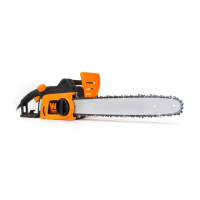11
OPERATION
SAWING TECHNIQUES
Saw off the lower branches on the tree first. By doing so, it is easier for the cut branches to fall to the ground.
At the end of the cut, the weight of the saw suddenly increases for the user since it is no longer being supported by
a branch. There is a risk of losing control of the saw, so make sure to stay alert during the entire sawing operation.
Only pull the saw out of a cut while the saw is running. By doing so, you prevent the chain from jamming in the
wood.
Do not saw with the tip of the guide bar. Do not saw into the branch formations (where the tree branches out-
wards). This will impede the tree’s ability to heal.
For sawing off smaller branches, place the stop face of the saw on the branch. This prevents unwanted movements
of the saw at the beginning of the cut. While applying light pressure, guide the saw through the branch from top to
bottom.
For sawing off larger branches, first make a relief cut. Saw through 1/3 of the branch diameter from the bottom to
top using the top side of the guide bar. Then saw from top to bottom for the other 2/3 using the bottom side of
the guide bar. Saw off longer branches in sections in order to maintain control over the location of impact.
PREVENTING KICKBACK
The term kickback refers to when the saw suddenly jumps up and back. This is usually caused by the workpiece
coming into contact with the guide bar tip or the clamping of the saw chain.
A kickback generates an abrupt powerful force. The saw usually reacts in an uncontrolled manner, creating the
possibility of injury to the user.
The danger of a kickback is greatest when attempting to cut near or with the guide bar tip. Always apply the saw as
flatly as possible in order avoid a loss of control during operation.
WARNING: Do not cut down trees in high wind conditions. This can result in injury and should only be per-
formed by a trained professional.

